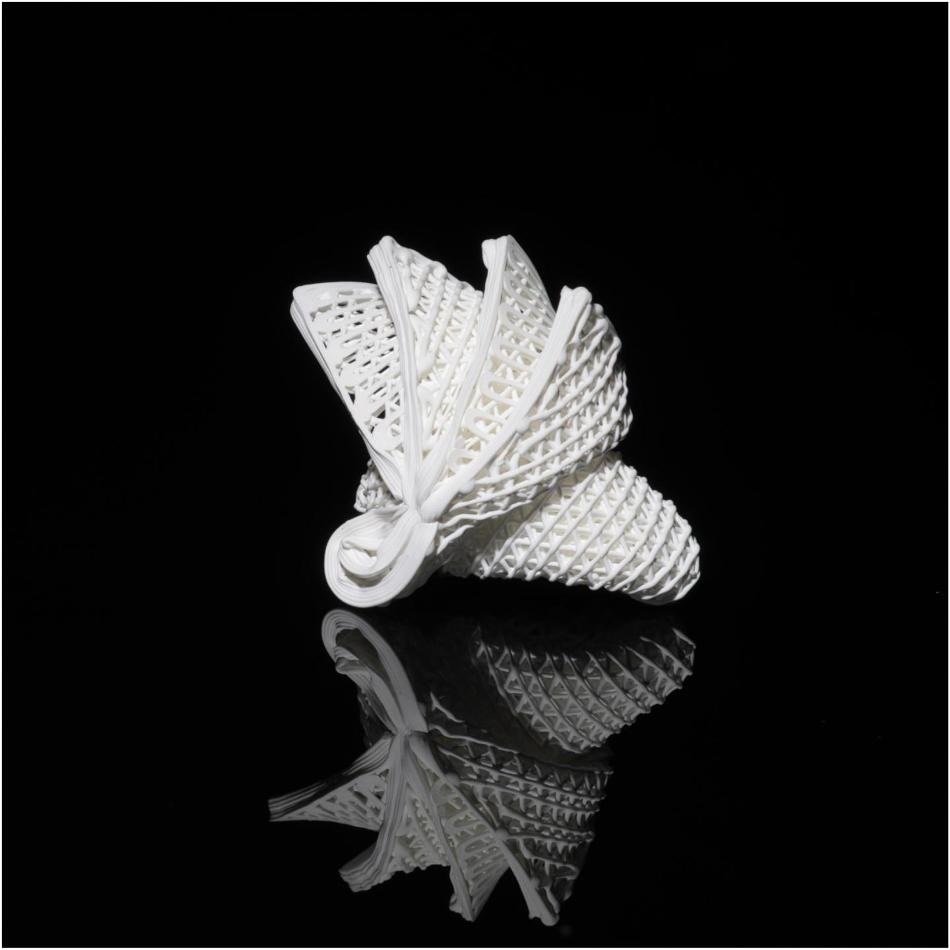Aug 20 2018
Researchers at City University of Hong Kong (CityU) have accomplished an innovative advancement in materials research by successfully creating the world's first-ever 4D printing for ceramics, which are mechanically strong and can have multifaceted shapes. This could unveil a new chapter in the structural application of ceramics.
 Printed ceramic origami mimicking the Sydney Opera House. (Image credit: City University of Hong Kong)
Printed ceramic origami mimicking the Sydney Opera House. (Image credit: City University of Hong Kong)
Ceramic possesses a high melting point, so it is hard to use conventional laser printing to create ceramics. The current 3D-printed ceramic precursors, which are typically hard to deform, also delay the production of ceramics with multifaceted shapes.
To handle these challenges, the CityU team has created a unique "ceramic ink", which is a blend of polymers and ceramic nanoparticles. The 3D-printed ceramic precursors printed using this novel ink are soft and can be stretched three times further than their original length. These flexible and stretchable ceramic precursors allow intricate shapes, such as origami folding. With suitable heat treatment, ceramics with multifaceted shapes can be accomplished.
The team was headed by Professor LU Jian, Vice-President (Research and Technology) and Chair Professor of Mechanical Engineering, who is an eminent materials scientist with research interests covering everything from fabricating nanomaterials and advanced structural materials to the computational simulation of surface engineering.
With the progress of the elastic precursors, the research team has accomplished one more innovation by formulating two techniques of 4D printing of ceramics.
4D printing is conventional 3D printing integrated with the extra element of time as the fourth dimension, where the printed objects can re-shape or self-assemble themselves over time with external stimuli, such as temperature, mechanical force, or a magnetic field.
In this study, the team utilized the elastic energy stored in the stretched precursors for shape morphing. When the stretched ceramic precursors are let loose, they experience self-reshaping. Following heat treatment, the precursors change into ceramics.
The resultant elastomer-derived ceramics are mechanically strong. They can possess a high compressive strength-to-density ratio (547 MPa on 1.6 g cm-3 microlattice), and they can be made in large sizes with better strength than other printed ceramics.
"The whole process sounds simple, but it's not," said Professor Lu. "From making the ink to developing the printing system, we tried many times and different methods. Like squeezing icing on a cake, there are a lot of factors that can affect the outcome, ranging from the type of cream and the size of the nozzle, to the speed and force of squeezing, and the temperature."
It took over two and a half years for the team to overcome the confines of the current materials and to develop the entire 4D ceramic printing system.
In the first shaping technique, a 3D-printed ceramic precursor and substrate were first printed using the innovative ink. The substrate was stretched with the help of a biaxial stretching device, and joints for connecting the precursor were printed on it. The precursor was then positioned on the stretched substrate. With the computer-programmed control of time and the release of the stretched substrate, the materials morphed into the intended shape.
In the second technique, the designed pattern was straightaway printed on the stretched ceramic precursor. It was then released under computer-programming control and experienced the self-morphing process.
The breakthrough has been reported in the newest issue of top academic journal Science Advances under the title "Origami and 4D printing of elastomer-derived ceramic structures". All research team members are from CityU, including Dr LIU Guo, Research Assistant, Dr ZHAO Yan, Senior Research Associate, and Dr WU Ge, Research Fellow.
"With the versatile shape-morphing capability of the printed ceramic precursors, its application can be huge!" said Professor Lu. One potential application will be for electronic devices. Ceramic materials offer much better performance in conveying electromagnetic signals than metallic materials. With the onset of 5G networks, ceramic products will play a more crucial role in the production of electronic products. The creative nature of ceramics and their capability to form intricate shapes also provide the possibility for consumers to tailor-make uniquely engineered ceramic mobile phone back plates.
Moreover, this innovation can be applied in the aero sector and space exploration. "Since ceramic is a mechanically robust material that can tolerate high temperatures, the 4D-printed ceramic has high potential to be used as a propulsion component in the aerospace field," said Prof Lu.
Pleased with the breakthrough in material and 4D-printing method advancement, Prof Lu said the following step is to improve the material’s mechanical properties, such as decreasing its brittleness.